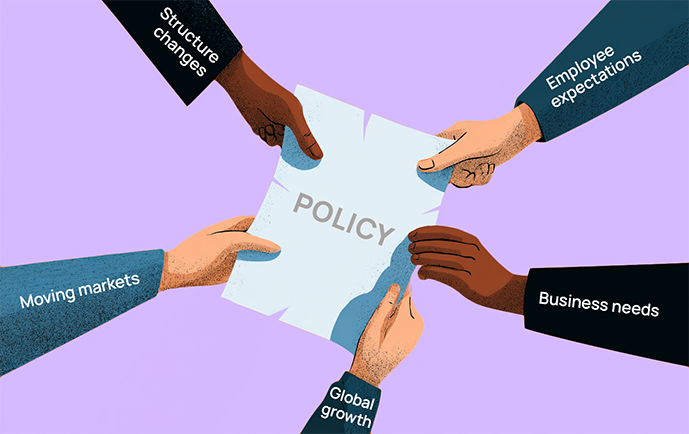How organisations are harmonising policy, practice and priorities heading into 2026
Alignment in Global Mobility (GM) doesn’t happen by chance. It takes ongoing effort from GM teams to ensure policies and practices remain in sync with business goals and employee expectations. Being aligned with market practice and being aligned with business goals don’t always go hand in hand.
Some companies aim to stay ahead of the curve, using support to attract and retain international talent. Others are focused on reducing costs, streamlining decisions, or bringing policy back in line with reality. Some are navigating structural change or global growth. Others simply want to know if their approach still makes sense today.

This post is part of our GM Evolution series and focuses on the Align Phase, where we look to support our clients with the above challenges. It’s where we take a step back and ask:
- Does your policy reflect how your business works today?
- Does it support what your business wants tomorrow?
- Is it used, understood and applied in the way it’s meant to be?
We combine benchmarking, stakeholder engagement and business priorities to identify where alignment exists, and where it does not.
What your Global Mobility policy needs to align with in 2026
Our priority is to assess whether your GM approach is delivering what it’s meant to. We make sure your approach reflects three key perspectives:
- Business strategy: growth targets, cost control, workforce planning
- Internal expectations: how the policy is understood and applied by HR, business leads and approvers
- Market/Industry practice: how your support compares to peers in similar sectors and locations
These targets are what we look to identify in our Discover Phase in your GM Evolution. The outcome of this phase ensures our clients know the answers to all the following questions:
- Is your policy still fit for purpose?
- Is it being applied consistently and understood clearly?
- Does it help your GM team lead, or get in the way?
With the answers to the above, you’re now primed to align.
Why benchmarking matters beyond the numbers
Benchmarking helps organisations assess how their approach compares to the wider market. But its real value comes when the insights are used to support strategic decision making.
Some companies focus on staying competitive. Others use the data to strengthen governance, reduce costs, or trial new Global Mobility models. Often, benchmarking is used either to validate an existing approach or to support a compelling business case for change.
The Global Mobility benchmarking areas ECA covers
With our abundance of surveys on all aspects of mobility, ECA holds global data that supports all angles of benchmarking required by our clients, from:
- Policy structure and eligibility
- Benefits and allowances
- Governance models
- Flexibility
- Emerging trends and practices
We tailor every benchmark to your context. The data sets the foundation, but the real impact comes from expert analysis aligned to your goals.

Where companies benefit from benchmarking:
- Bottom-left: Policy falls behind market practice and does not connect to business needs
- Bottom-right: Aligned to the business but not competitive
- Top-left: Above market practice, but not aligned to the business
Just because companies are aligned with the market doesn’t mean they’re aligned with their company goals. The aim of our benchmarking is to move all organisations to a position where their policy is both competitive and strategically aligned.
Why stakeholder alignment is critical for an effective Global Mobility policy
We often find that what the policy says, and what people think it says, are two very different things.
That’s why we look to include structured stakeholder engagement in the Align Phase. We speak with HR, Talent, Reward, business line leads and other internal users of the policy to understand:
- What they believe the policy is for
- Where they’ve seen grey areas or inconsistencies
- How decisions are made in practice
- What they need from Global Mobility going forward
These conversations often reveal real gaps that are holding the GM function back.
In one case, stakeholder engagement revealed that the business viewed the GM function as a blocker to fast-paced mobility. As a result, teams were bypassing the function entirely. This insight highlighted that policy alone wasn’t enough to change perceptions. The solution included stakeholder training and new internal guidance materials to reposition the GM function as an enabler which aligned with business needs rather than standing in their way.
What the entire Align Phase delivers
By the end of this phase, you’ll have:
- A clear view of your position in the market
- Insight into how your policy is understood internally
- A breakdown of misalignments between intent, impact and expectation
- Practical recommendations and priority areas for change
- A foundation for confident decision-making
Close the gaps in your Global Mobility policy - with confidence
Within our wider process of GM Evolution, our Align Phase is vital where your policy no longer reflects how your business operates, or if expectations across teams don’t align. We’d be happy to talk through how our benchmarking, structured input and tailored recommendations can help bring focus, clarity and direction to your Global Mobility approach. If you’d like to chat through your current challenges, feel free to get in touch - we’re always happy to help.
Our GM Evolution approach is a phased process to redesign policy, improve governance, and make GM more strategic and effective.